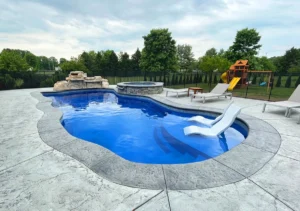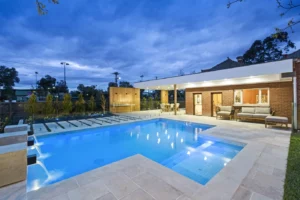Installing a swimming pool can be an exciting project that adds value to your home, enhances your lifestyle, and creates a space for family fun. However, many homeowners are unsure about where to start or what steps are involved when they decide to install a swimming pool. This blog will walk you through the entire process of swimming pool installs, from the initial design phase to the final completion.
Whether you’re considering adding an in-ground pool to your backyard or upgrading your existing pool, understanding the process is key to a successful installation. Let’s break it down step by step.
The Key Challenges of Install a Swimming Pool
Before diving into the process, it’s important to understand the common challenges homeowners face when you install a swimming pool:
- Choosing the Right Design and Type: There are so many pool types and designs to choose from. Whether it’s a fiberglass pool, a vinyl-lined pool, or a concrete pool, each option has its pros and cons.
- Budget Management: Knowing the total cost of swimming pool installation, including materials, labor, permits, and maintenance, is often challenging.
- Choosing a Reliable Installer: It’s critical to work with an experienced swimming pool installer who can deliver the quality you expect.
- Time Management: Pool installations can take time, and any delay or misstep in the planning stage can push your project back.
The Complete Swimming Pool Installation Process
1. Initial Consultation and Design
The first step in the swimming pool install process is the initial consultation with a professional installer. During this phase, the pool installer will visit your property and assess your available space. They will discuss your needs and preferences, such as the pool size, shape, depth, and features (e.g., lighting, waterfalls, or heating systems).
Once the installer understands your vision, they will provide you with a design plan. It’s essential to choose a design that fits your yard and lifestyle while complementing your home’s overall aesthetics.
2. Planning and Permits
After finalizing the design, the next step is to handle the necessary paperwork. Obtaining permits and approvals from your local municipality is crucial for ensuring the pool installation meets building codes and safety standards.
Your swimming pool installer will typically take care of this process, including submitting the required documents and ensuring all regulations are followed. This will help you avoid delays or issues down the road.
3. Excavation and Site Preparation
With the permits in hand, it’s time to begin excavation. This is one of the most critical phases of the swimming pool installation process. A professional installer will use specialized equipment to dig the hole for the pool, ensuring that it matches the exact dimensions of the design.
The excavation process will also involve removing any debris, rocks, or roots that may be in the way. It’s important that the ground is level, as this will impact the stability and safety of your pool.
4. Building the Pool Structure
Once excavation is complete, the pool’s structure begins to take shape. This step varies depending on the type of pool being installed:
- Fiberglass Pools: Pre-manufactured fiberglass shells are delivered to the site and placed in the excavated area. The installer will then secure and level the pool shell.
- Concrete Pools: For concrete pools, the installer will build the walls and floor by pouring concrete, which is then smoothed and shaped into the pool’s desired form.
- Vinyl-Lined Pools: After installing the framework, a vinyl liner is attached to the pool structure.
During this stage, your installer will also handle the plumbing and electrical work necessary for the pool’s filtration, lighting, and heating systems.
5. Installing Pool Equipment
Once the pool shell is in place, the next step is to install the pool’s equipment. This includes the pump, filter system, skimmer, and any other necessary components.
The installer will ensure that everything is hooked up correctly and tested to ensure it functions properly. Proper installation of equipment is essential to keeping your pool clean and running smoothly throughout the year.
6. Decking and Landscaping
After the pool’s structure and equipment are in place, it’s time for the finishing touches. The area surrounding your pool will be landscaped, and decking will be added. Decking can be made of various materials, such as concrete, stone, wood, or tile, depending on your style and budget.
Landscaping is also an important step in creating a relaxing outdoor oasis. Many pool installers will offer suggestions on how to incorporate plants, lighting, and other features that enhance the pool area.
7. Final Inspection and Testing
Before you can enjoy your new pool, a final inspection will be conducted. This is when your installer will double-check everything: the pool equipment, electrical systems, and plumbing. They will ensure everything is up to code and functioning properly.
Additionally, the pool will be filled with water, and the pool systems will be tested to ensure there are no leaks or issues.
8. Pool Maintenance and Care
Once your pool is installed, it’s essential to maintain it regularly. Pool maintenance includes cleaning, testing water chemistry, and ensuring that the pump and filtration systems are functioning properly. If you’re unsure of how to maintain your pool, many installers, like AI Signature Pool Solutions, offer ongoing maintenance services to keep your pool in top condition.
Why Hiring a Professional Swimming Pool Installer is Essential?
While it may be tempting to install a swimming pool yourself, hiring a professional swimming pool installer ensures that the job is done correctly, safely, and efficiently. Here are some reasons to choose an expert installer:
- Experience and Knowledge: Professional installers have years of experience and know the best practices for building pools that are safe and durable.
- Time-Saving: They have the tools, manpower, and resources to complete the installation quickly and correctly.
- Legal Compliance: A professional installer ensures that your pool meets all local building codes and safety regulations.
- Long-Term Benefits: A well-installed pool lasts longer, requires less maintenance, and increases your property’s value.
Conclusion
Installing a swimming pool is a significant investment that requires careful planning and execution. With the help of a professional swimming pool installer like AI Signature Pool Solutions, you can ensure that the job is done right. From design to installation, our team is here to guide you every step of the way. We specialize in swimming pool installs that are built to last, providing you with a backyard oasis to enjoy for years to come.
Contact AI Signature Pool Solutions today to schedule your consultation and take the first step toward installing your dream pool. We offer expert swimming pool installation services with exceptional results.
FAQs
1. How long does it take to install a swimming pool?
The installation process can take anywhere from a few weeks to a few months, depending on the complexity of the design, type of pool, and weather conditions.
2. What is the best type of swimming pool for my home?
The best pool for your home depends on your budget, yard space, and design preferences. Common options include fiberglass, concrete, and vinyl-lined pools.
3. Do I need a permit to install a swimming pool?
Yes, in most areas, you will need a permit to install a swimming pool. A professional installer can help with the permitting process to ensure compliance with local regulations.
4. How much does it cost to install a swimming pool?
The cost of installing a swimming pool varies widely depending on the type of pool, size, and additional features. On average, swimming pool installs can range from $20,000 to $50,000 or more.
5. How can I maintain my pool after installation?
Pool maintenance includes cleaning, testing water chemistry, and checking the equipment. You can hire a professional or do it yourself with the proper tools and guidance.



